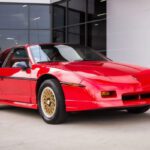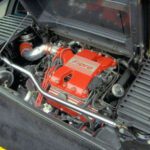2023 Pontiac Fiero
The 2023 Pontiac Fiero is a mid-engine sports car manufactured and marketed by Pontiac. The Pontiac Fiero was designed as a sports car by George Milidrag and Hulki Aldikacti, the Pontiac Fiero was the first two-seater, Pontiac is the first mid-engined sports car mass-produced by an American manufacturer. Unfortunately, as the sports car came close to its original designer’s vision and began rewarding its drivers, GM undermined the Fiero. The Fiero car’s reputation for catching fire, poor quality, and steadily falling sales has pushed it into the scrap heap of history.
The progressive technologies incorporated into the Pontiac Fiero design included composite panels that were unique for their time. Other features included hidden headlights and integrated stereo speakers in the driver and passenger headrests. The Pontiac C8 and Pontiac Fiero are both obtainable exotics; Cars that have the style and presence of something Italian and expensive, but American and affordable. The Fiero is also popular as it has been made into Lamborghini and Ferrari replicas, along with other custom car kit modifications.
- Pontiac Fiero Modified
- Pontiac Fiero GT Car
- Pontiac Fiero Formula
- 2023 Pontiac Fiero GT
- Pontiac Fiero 1988
- Pontiac Fiero Body Kit
- Pontiac Fiero Engine
- Pontiac Fiero F9
The Fiero was conceived as a small two-seater sports car with an all-new suspension and a V6 engine. Rather than investing in a second two-seater sports car that could compete with the Corvette, General Motors management was able to sell the Fiero concept to the company in 1978 as a fuel-efficient four-cylinder “commuter car”. This one had two seats instead of a muscle car. Production was greenlit when engineers brought back a working prototype in less than six months.
On a basic level, it meant the Fiero was stuck with a salvaged front suspension from the dreaded Chevrolet Chevette, and the rear suspension was pretty much the buttress of those crappy X cars moving in the stern. Power steering was not available, making parking the car difficult for some drivers. And of course, there was the trash Iron Duke, it melted down after some Fiero’s engine fires.
Pontiac Fiero Design
The Fiero was a two-seat, mid-engine, rear-wheel drive coupe. Originally available in a notch body style, Pontiac later offered a fastback profile. It had concealed pop-up headlights, a short, low nose, and a rather long, square tail. Exterior decorations were kept to a minimum, with no chrome and minimal plating. Some models had a large rear wing, others had smaller wings and what looked like rear luggage racks, but were probably never used. Now common among sports cars, the way Pontiac built the Fiero was unique at the time. Instead of structural body panels, the Fiero used a steel space frame under non-structural composite body panels. The company later used the construction method for many Saturn products.
Pontiac Fiero Interior
Inside, Fiero is a high point for the interiors of American brand cars. The designs of the time were blocky and unimaginative, the build quality was atrocious, and the materials were tough, cheap, and unforgiving. Fiero embraced each of these stereotypes. Given its position as an economy car, Pontiac designers had no choice but to go cheap on the interior. One thing they were right about, though, was the Fiero’s sculpted sports seats, which could hold passengers firmly in place at much higher speeds than the Fiero could have. In an innovative twist, the headrests featured speakers.
The Pontiac has adorned the interior with Fiero winged horse logos, which is a bit confusing. That’s because the artwork was based on Pegasus, a name that Fiero bore most of its development. The model was renamed Fiero just before its release, engineers were stubborn about their signature 2-seater sports car concept. That’s why they sold the Fiero, originally conceived as a small “sport” car, to the company as a small and fuel-efficient commuter car.
Pontiac Fiero Engine
Pontiac-powered Fiero with the V-6 engine option was added as part of a new GT model for 1985, and a five-speed transmission became part of the package. Pontiac debuted the Fiero with a 2.5-liter four-cylinder engine and produced 92 horsepower. The poorly paired four-speed manual transmission exacerbated the lack of power, a three-speed automatic transmission was available.
The 1984 Pontiac Fiero 2M4 four-cylinder with the standard four-speed manual transmission earned EPA fuel economy estimates of 21 mpg in the city and 33 mpg on the highway. Choosing four mpg auto-played highway mileage estimation. Later V6-equipped models did not fare as well in the fuel economy department. Equipped with a five-speed manual, the 1988 Fiero 2M6 could only pack 15 mpg in the city and 25 mpg on the highway.
Pontiac Fiero Safety
The unique plastic body-space frame design helped the Fiero achieve a five-star NHTSA NCAP frontal crash test rating, the highest rating available. The Fieros caught fire at a rate of one for every 508 cars sold, outstripping all other mass-market auto cars. The Associated Press quoted the National Highway Traffic Safety Administration as saying that the Pontiac Fiero caught fire, including six injury reports.










